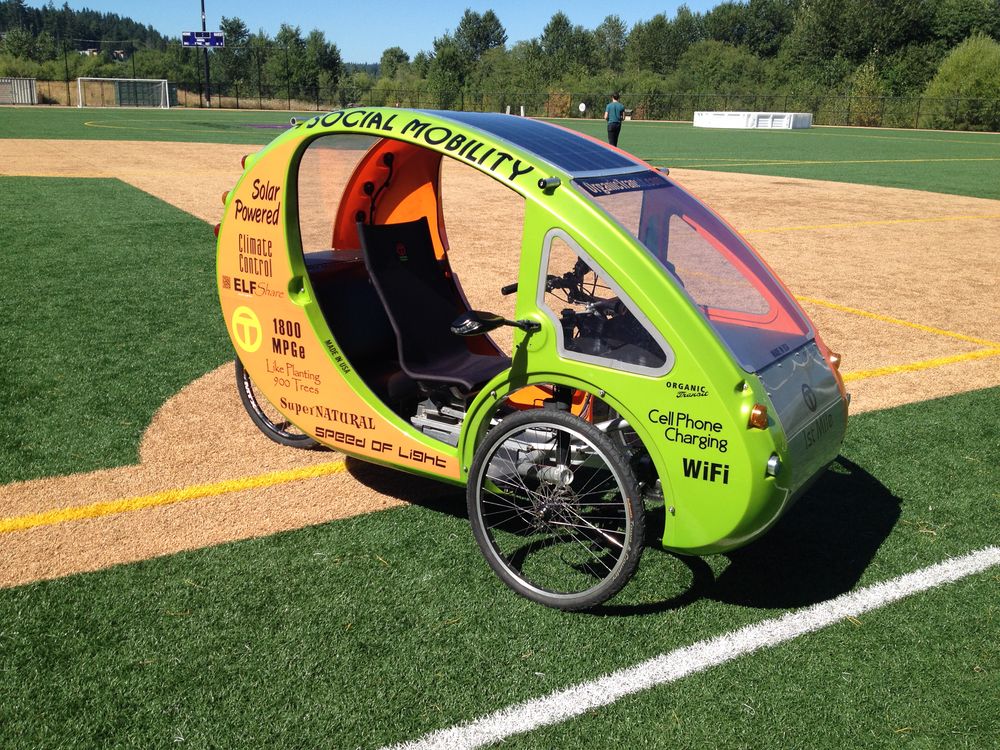ElcanoIntro
Contents
Elcano Project Introduction
Vehicles
A self-driving vehicle does not have to be a car. It can be a bicycle or motorcycle. We work with tricycles so that we do not need to worry about balance. Other vehicles could be karts or toy cars. At University of Washington Bothell we have two Catrike recumbents and an Organic Transit ELF. In 2018, version 3 of the High Level System was built. It has the capability of outputting in CAN Bus format, which is the standard for automotive control. With a CAN Bus interface on Low Level a trike can present the same automation interface as a car.
Automation of the ELF vehicle has started with the steering system, which is described in the attached document.
Theory
Self-driving vehicles like Elcano can increase passenger safety, reduce the energy used for urban transportation, and reduce vehicle congestion. Over 90% of traffic accidents are caused by driver error, so the safety potential of self-drive is well-understood. When self-drive almost eliminates traffic accidents, a motorcycle is almost as safe as a full-frame automobile. Vehicle weights could fall to the point that pod-cars weighing less than the riders are the preferred choice in urban environments. Since 65% of U.S. vehicle miles traveled (VMT) are urban, the ramifications are enormous. Self-driving vehicles can drive a pre-determined speed on a pre-determined route, eliminating unpredictable driver behavior that causes sudden traffic stoppage and congestion. An aerodynamic ultra-light vehicle that avoids stop-and-go traffic needs less than one-tenth the energy of an automobile; a 25 pound rechargeable battery and a small electric motor on a light vehicle achieves the speed and range required for urban transportation. Light batteries can be easily swapped when exhausted, eliminating range anxiety. A bank of batteries can be recharged when the wind blows and the sun shines. Fossil fuel demand, pollution and green house gas production could fall dramatically.
For most people, transportation automation is rocket science. The Elcano Project aims to make self-drive real for students and hobbyists, and build a popular demand to adopt traffic automation. The technology is here; laws and policies to take advantage of it are not.
An isolated autonomous car can improve safety, but the other benefits require choreographing road users; when done right, highway capacity goes up three times and congestion mostly disappears. If manual and automated traffic were allowed to mix, the manually driven cars would snarl up the automated lane; thus there needs to be separated lanes. A lane set apart for automated vehicles looks a lot like Personal Rapid Transit (PRT), a technology that has been around for more than 40 years. Today PRT systems are in operation; other automated road systems are only at the testing phase.
When an automated vehicle is in a reserved lane, the sensors get simpler and less expensive; there is no need for lidar, radar or extensive machine vision because lane traffic is synchronized and predictable. The Elcano Project provides a blueprint for building your own inexpensive experimental automated vehicle using electronics and sensors. A tricycle with an electric motor under 750 Watt and top speed under 20 mph is legally a bicycle, and thus street-legal without license, registration or insurance.
Use of Arduino microcontrollers for Elcano
As you might be just taking your first dive into this project, it is important to know that most of our microcontrollers are manufactured by Arduino. Arduino is one of the largest producers of such development tools and have found great success in creating cheap ways to make them available to the public. Although generally affordable, these boards are mainly intended for prototyping and have rates of failure that may be too high for a production system. It still provides a great base for developers to create new systems. For more information refer to https://www.arduino.cc/ --> the website also has a lot of information about their products from programming to forums so don't be afraid to look things up! Note that Arduino hardware is an open source design based on Atmel AVR. Since our boards are also open source, you have the possibility of designing a single board that merges the Arduino and Elcano functionality.
System Architecture Overview
Elcano converts an ordinary vehicle to self-drive by adding several classes of hardware, including:
- Processors that use data from the sensors and data from on-board storage to control where the vehicle goes.
- Actuators to control steering, braking, and vehicle speed. Actuators are often servomotors but can be other devices.
- Sensors to measure vehicle speed, vehicle location, vehicle direction, obstacle distance, and other information about the vehicle and its surroundings.
- Electrical Power comes from a bank of batteries, either tapped for multiple voltages or through power converters.
The processors, actuators, sensors, and power subsystem are all located somewhere on the vehicle. Physical Architecture describes where each part is on the vehicle and the location of wires connecting each subsystem.
NEXT > System Architecture
